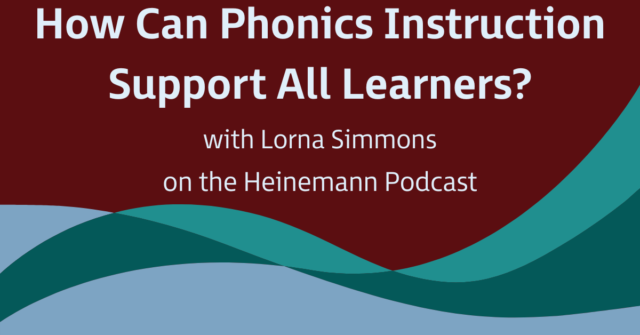
Do you ever find yourself excitedly teaching a lesson only to look out and see wide eyes staring back at you? Do you ever think, “I have said that a million times, Bb represents the sound /b/? Well, it may be that something in your delivery is falling short and it turns out that a popular home design guru—Marie Kondo can offer some insight. Marie Kondo is the Japanese organization expert taking the world by storm right now, reminding us all to declutter our homes and our lives. As it turns out, we can also “declutter” our teaching language.
How to Avoid Verbal Clutter in Phonics Instruction
In addition to using clear language and providing helpful feedback, teachers should be mindful of extra talk in their lessons. High-quality phonics instruction uses simple, purposeful talk that focuses the reader on just one thing at a time. The talk is delivered at a pace that can be processed by the learner, and the teacher punctuates the question or comment with a pause.
Without realizing it, a well-meaning teacher can fire five different questions and requests at a student: “Okay, what is that word? What does it say? Hmmm, what’s at the beginning of the word? Look at the word. Um. Think about what other word this is like.” The student is completely confused.
Follow these tips to avoid verbal clutter:
- Add pauses to your teaching. Everyone talks about wait time for students, but teachers need wait time too. Don’t let yourself feel rushed or pressured to cover everything. Rushed teaching is bad teaching. So add more pauses before you talk. It will feel awkward at first, of course, but really all you’re doing is giving yourself time to get centered on what’s the best thing to say, rather than just talking. You can just say to yourself, “Pause,” and just think for ten seconds.
- Remember that less is more. During instructional sequences, less talking and verbiage will usually be better, especially with young learners. The young learner is going to respond better to a simple question or prompt as opposed to a longer one. Try to avoid filling the instructional space with fillers (e.g., like, okay, you guys, yeh?, right?). These vary by region of the country, but they are equally distracting.
- Check the pacing of your voice. Many people, when nervous, will talk more quickly and use a high pitch. This makes a direction or question even more difficult to follow. It can also add urgency and stress to the request, even if that is not the intention. For learners in pre-K through first grade, talk in a pace that is slightly slower than the pace you would use with adults.
- Pause and give sufficient wait time after making a request. One of the instructional mistakes that teachers make is not waiting long enough for students to respond and then asking another question quickly to remedy the situation. Sufficient wait time is usually around five seconds. It may feel uncomfortable to you, but children need it. Before rephrasing a question, simply ask it again and wait.
- After giving a direction, look at the word or letter—the instructional target. When young children hear someone talking to them, their obvious response is to look at the person and engage in conversation. This is central to oral language development. However, in a teaching interaction, the object of focus is not the other person but the activity—the word card, letters, or dry erase board. When a teacher visually focuses on the instructional activity, there is a clear message to the student to look as well. And that’s what we want children to do as they read words: look at them.
- Know how you want the learner to respond. Often verbal clutter occurs because the teacher says the first thing that comes to mind and then realizes that something else is better for getting the desired response. Think about what the learner should do or say as the result of your prompt. This does not mean that you should be restrictive and limit children’s inquiry; rather, you should be prepared for possible responses and should use language that is as precise as possible to help solicit responses.
- Plan for verbal precision. Good lesson preparation tends to decrease verbal clutter. Planning key parts of what you are going to say, even if only in your head, helps make your language more precise. You’ll find that the more precise and focused your language is, the more precise and focused children’s attention is. Talk is a major tool of teaching and we should treat it that way. Practice your lesson language in the car on the way to school, in the shower, or with your pet. Many teachers like to use a little sticky note or note card beside them as they are teaching to remember important language. Throughout the book, I’ll be referring to such language as “catchphrases.”

Heidi Anne E. Mesmer, PhD, is a Professor in Literacy in the School of Education at Virginia Tech. A former classroom teacher, she works extensively with teachers, schools, and young readers, directing numerous school-based initiatives to improve reading instruction. Heidi Anne studies beginning reading instruction and text difficulty and her work has been published in The Reading Teacher, Reading Research Quarterly, The Educational Researcher, Elementary School Journal, and Early Childhood Research Quarterly. She is the author of Tools for Matching Readers to Texts, Reading Interventions in Primary Grades, and Teaching Skills for Complex Texts.


